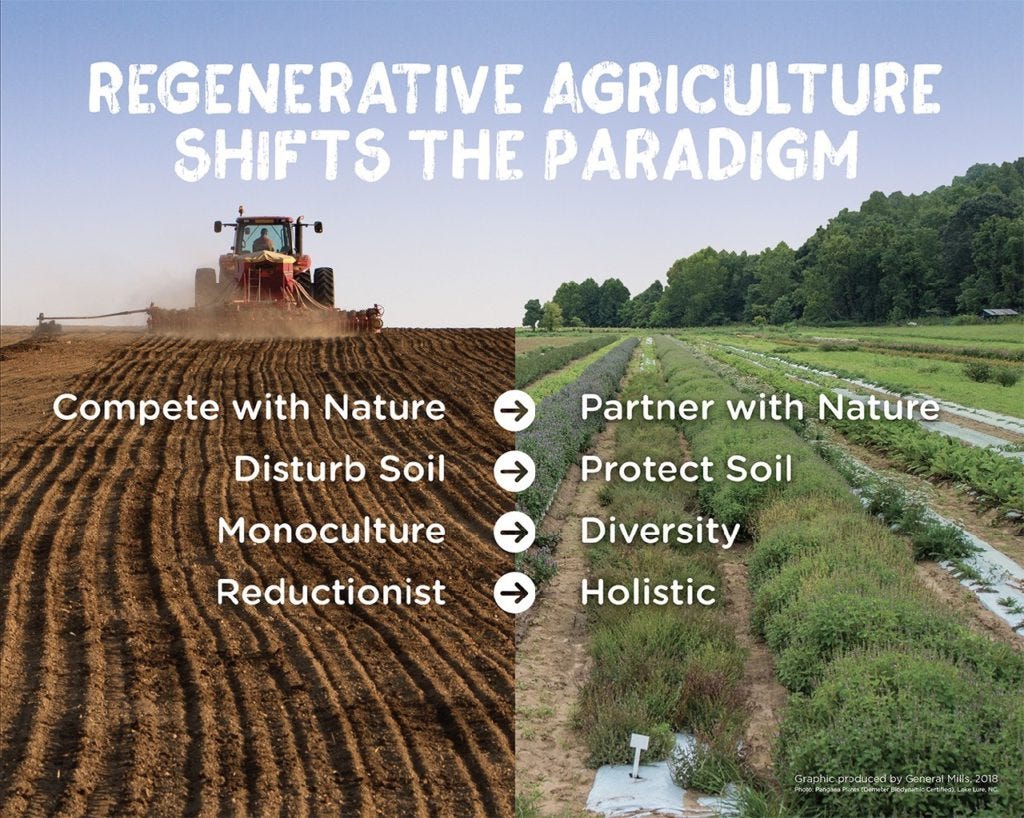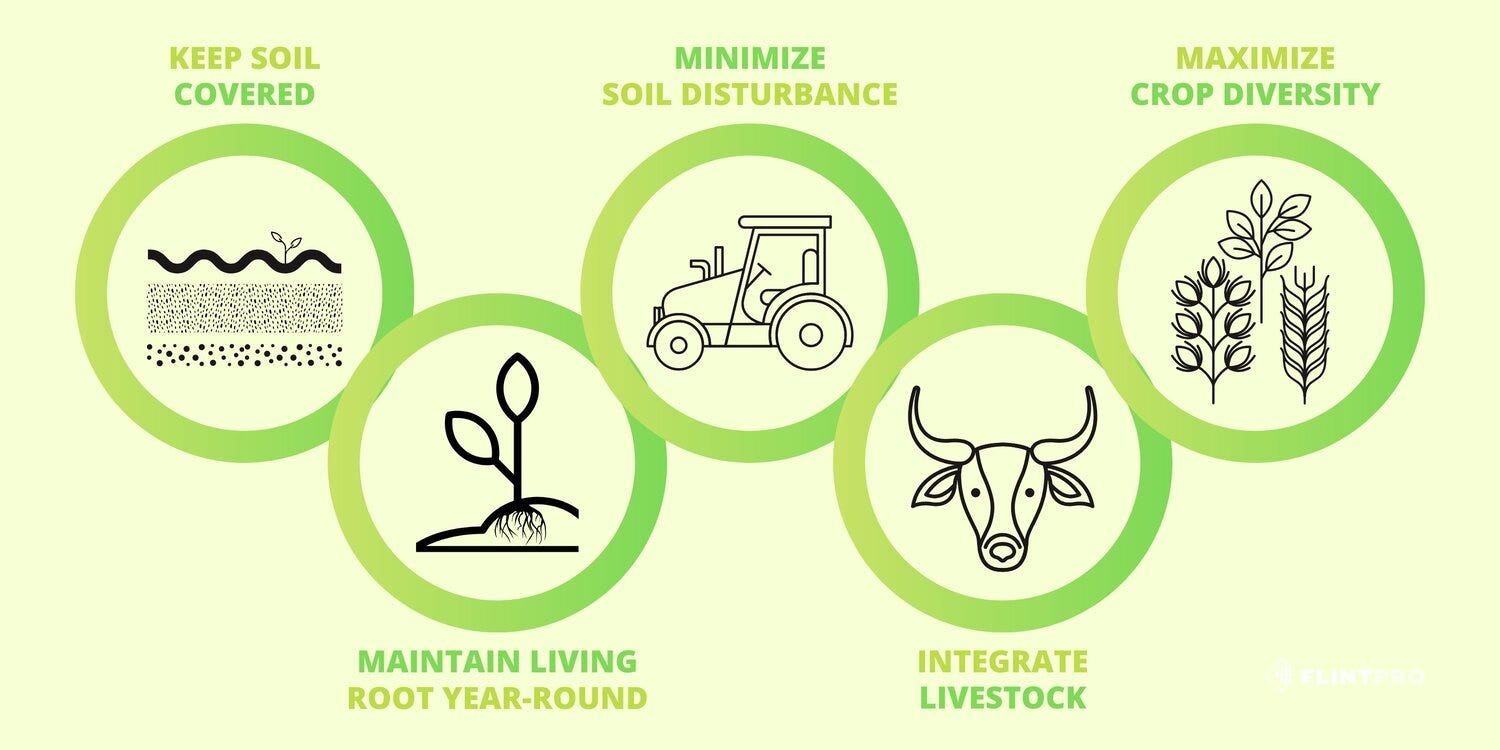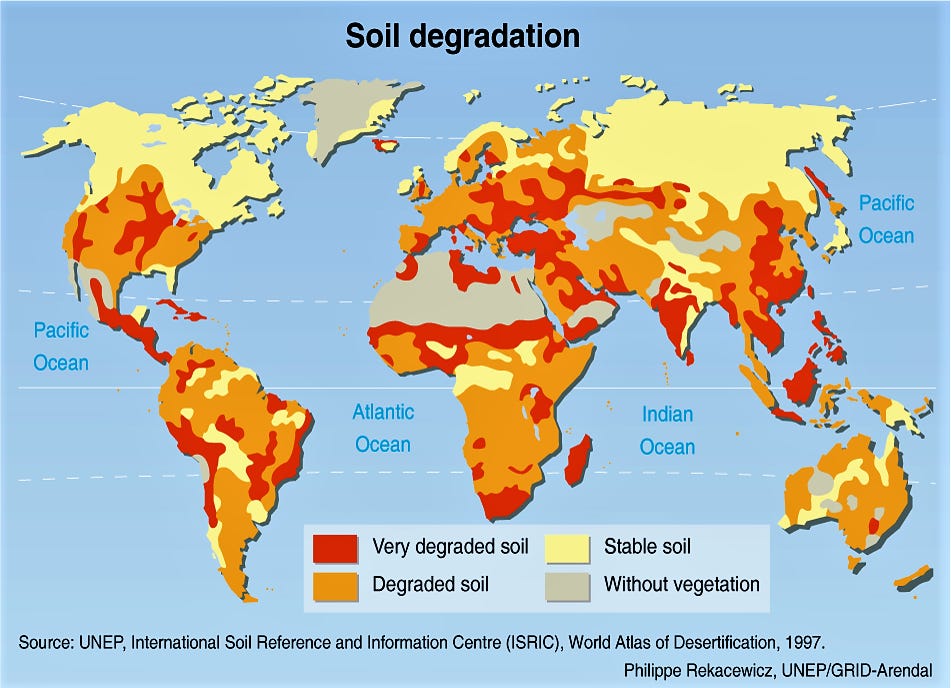Overfed & Undernourished Pt 1/2
“Food as a Weapon, a two part series”
To read the second release, go here.

Jack Swigert and Gabe Brown may have next to nothing in common on paper.
John "Jack" Swigert was a test pilot, aerospace engineer, politician, and NASA astronaut who coined the expression ingrained in most people's memory from the Apollo 13 space mission - "Houston, we have a problem."
Gabe Brown is a farmer, author, and pioneer in the regenerative agriculture practice who, maybe slightly less well-known than Jack - became known for the expression in his book Dirt to Soil - "[Houston], we are overfed and undernourished." Author's note: it did not feel appropriate to omit the exclamatory value of Houston from both quotations.
For Jack, his problem came with a jolt. As his spacecraft rocked, the alarm sounded, and the infamous communications with NASA began.
For Gabe, his problem came silently. A transient man would never have seen the problem, but thankfully Gabe had been working on his land for years or at least long enough to diagnose the problem: his soil. Over several decades, and primarily due to embracing traditional farming practices centered around the production model, his land had become infertile ****- more on that later.
Tick-tock - not the app
Fifty-five hours 55 minutes and 4 seconds into the Apollo 13 mission, mission control recorded a shift in the High Gain Antenna communications, prompting them to restart the central computer to rush to diagnose the pending problem. Jack's sobering touch to Houston confirmed the team's worst fears - but did the team have the resources and ability to salvage the mission? Neither the team in Houston nor the team in orbit knew the answer, but one thing was clear - they needed to move quickly to find out.
At fourteen minutes from the initial jolt, oxygen tank 2 read zero, meaning the team had roughly two hours of oxygen remaining. Suddenly, a moon landing seemed unlikely. The mounting sense of urgency sent panic through the room. With the moon landing off the table, the team had to correct course to get them heading home. The pressure to get the team home grew by the minute.
At ninety minutes, oxygen tank one slowly moved closer and closer to zero. The spaceship had 15 minutes of power left. The team of three rushed to the lunar module to use it as the aircraft to return home. The whispers from the ground described the circumstances as the worst they had experienced with a crewed spacecraft. Luckily, the team acted quickly, made swift decisions, followed the systems in place, and improvised when needed.
Jack and the team returned home on one of the most iconic system failures in NASA history. Some schemes fail in plain sights, like the Apollo 13 mission; Others grow quietly and less noticeably - enter Gabe.
Cock a doodle doo - it's time to wake up!
Unlike Jack, Gabe did not have a NASA alarm to alert him of his problems. Years and years of hard work had led Gabe down a path of no money and an unproductive farm in Bismarck, North Dakota. The issue had little to do with Gabe and much to do with the system in which Gabe learned to operate his farm. To make matters worse, fixing the problem takes some severe course correction - money, time, and a complete change in the industry standards.
For years, the US schools taught methods based on the production model, preaching the need for tillage, synthetic fertilizers, herbicides, pesticides, and fungicides. Each of these practices plays a significant role in the degradation of our soil biodiversity in the US. Since implementing these practices, we have seen nearly 90% of the natural biodiversity disappear during the 20th century. Unfortunately, like most problems developed over long periods, it takes a keen eye, knowledge, and more time to reverse the situation.
Sadly, the production model has broken real incentives for farmers due to the federal crop insurance regulations signed into law in 1938. Want to hear something shocking? Gabe discussed a crowd of corn and soybean producers in Nebraska, and he asked how many farmers had turned a profit last year. Only one person raised their hand. He then asked how many people planned to continue to grow corn and soybean the following year, and every person raised their hand. How does that make sense? The incentives engrained in the system's structure allow farmers to stay in business growing single crops using the production method of farming. The motivations for our farmers are broken. The subsidies intended to feed the world now support the continuation of these environmentally harmful practices, loss of biodiversity, and the degradation of our soil in America.

For Gabe, he had a dire need to address the lack of biodiversity on his farm. With no money to his name, he focused his practices on his farm by farming by nature by promoting biodiversity at all farm levels, reducing the use of harmful chemicals, and integrating livestock into the pastures. As a result, his farm flourished. The carbon content in his soil had surpassed other local farms by 3x, and he outproduced them in terms of yield by 20%.

Gabe only represents a tiny regenerative agriculture community in the US. Most of our food production still comes from large industrial farms practicing the production model of farming. The evolution of our farming industry helps tell some of this story - in 1900; the US had roughly 7 million farmers. Today, we have just over 2 million. To make matters worse, 5% of the industrial farms in the US represent 75% of our food production. The concentration amongst the large farms poses a massive issue for the industry's health as it becomes more expensive and harder to turn a profit on a farm. Think about this - three companies control over 75% of the agrochemical industry. Three companies supply over 90% of the breeding stock of layers, broilers, turkeys, and pigs. Four firms control half to three-quarters of all animal slaughter, depending on species. Five companies own over 50% of the farm machinery market. The price control and power held over farmers because of the structural issues regarding concentration create immense challenges to generate real profit for farmers. The farming industry serves as the bedrock of our society. Sadly, the industry stands to see more and more farmers either run out of business or be absorbed by industrial farming practices.
The soil problem Gabe faced is just one example of a broader problem across the Globe. Today, we are faced with a global crisis regarding nutrient degradation in our soil, and it transcends multiple layers of the entire environmental and health-related problems we see in the world today. Most people fail to realize that the lack of nourishment in our food today comes from the farming practices draining our soil’s richness. Let's take oranges, for example. Today, we need to eat eight oranges to get our grandparents’ same nutrients from one. Nutrient degradation in our soil poses a severe threat to our ability to feed 9 billion people by the year 2050 in a way that promotes vitality and a healthy way of life.

The information surrounding these topics is quietly discussed in small corners of the world. As people rant about climate change, rapid increases in chronic diseases like diabetes and heart disease, rising costs of health care, and inequality, few people have posed a legitimate plan to create a sustainable and healthy path forward. How can we rewrite our course and solve the problems underpinning our farming, food, and healthcare system? The answer is simple but not easy - educate people on the importance of our food choices and fortify our food system through embracing regenerative farming practices.
I plan to voyage through many of the topics discussed in my prelude article today for the next few weeks. I plan to discuss:
- The Current System: The Production Model
- The Future System: Regenerative Agriculture
- The State of the Farming Industry: The Convergence of the Past and Future of Farming
- A Global Crisis: Nutrient Degradation, Chronic Disease, and the State of Healthcare in the US
- The Path Forward: Let's Create a Plan and Act!
Written by: @cannoliclemenza